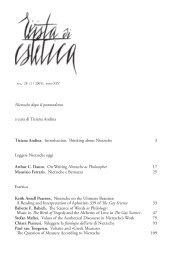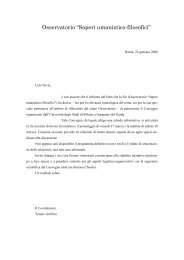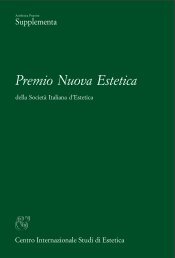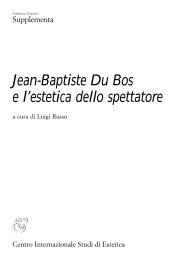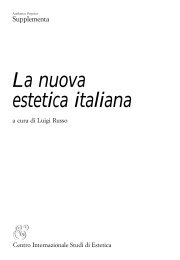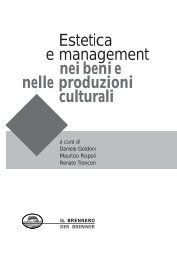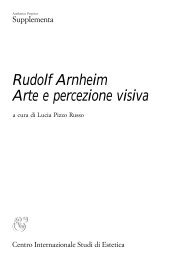Guido Morpurgo-Tagliabue e l'estetica del Settecento - SIE - Società ...
Guido Morpurgo-Tagliabue e l'estetica del Settecento - SIE - Società ...
Guido Morpurgo-Tagliabue e l'estetica del Settecento - SIE - Società ...
You also want an ePaper? Increase the reach of your titles
YUMPU automatically turns print PDFs into web optimized ePapers that Google loves.
<strong>Guido</strong> <strong>Morpurgo</strong>-<strong>Tagliabue</strong> and 18th-Century AestheticsThe International Centre for the Study of Aesthetics commemoratedthe 5th anniversary of the death of the renowned Italianscholar of Aesthetics <strong>Guido</strong> <strong>Morpurgo</strong>-<strong>Tagliabue</strong> (1907-1997) bypublishing a collection of his essays on the notion of taste in 18thcenturyItaly and Great Britain. The collection is entitled Taste in18th-Century Aesthetics (Aesthetica Preprint: Supplementa, 11,2002, 256 pp.). The remarkable importance of this volume, whichrepresents a very significant contribution to the history of the notionof taste in 18th-century Europe, inspired the organization ofan international convention on <strong>Guido</strong> <strong>Morpurgo</strong>-<strong>Tagliabue</strong> and18th-century aesthetics. The convention took place in Palermo(Italy) on November 1-2, 2002.The present volume collects lectures and papers presented at thatconvention. The editor, Luigi Russo, opens the volume with anessay (“A Martian in Aesthetics”) that provides an interestingdescription of <strong>Guido</strong> <strong>Morpurgo</strong>-<strong>Tagliabue</strong> and illustrates the relevanceof his scholarship in the historiography of Aesthetics of thesecond half of the 20th century. The other essays included in thevolume (i.e., Giuseppe Sertoli, “<strong>Morpurgo</strong>-<strong>Tagliabue</strong> and 18th-Century English Aesthetics”; Andrea Gatti, “Aporia and Dialecticof Taste”; Paolo D'Angelo, “<strong>Morpurgo</strong>-<strong>Tagliabue</strong> and the Aestheticof Taste in 18th-Century Italy”; Salvatore Tedesco, “<strong>Morpurgo</strong>-<strong>Tagliabue</strong>and Italian Aesthetics in the Early 18th Century”;Roberto Diodato, “The Judgement of Taste. Essay on <strong>Morpurgo</strong>-<strong>Tagliabue</strong>’s Thought”; Giovanni Matteucci, “Implications of theRelationship between Taste and Judgement in <strong>Morpurgo</strong>-<strong>Tagliabue</strong>’sWork”; Giuseppe Di Giacomo, “The Notion of Family,Class, and the Individual in <strong>Morpurgo</strong>-<strong>Tagliabue</strong>’s Reflection onAesthetics”) foreground specific aspects of <strong>Morpurgo</strong>-<strong>Tagliabue</strong>’sscholarship that are considered to be particularly meaningful fromboth a historiographic and a theoretical point of view.The Appendix features the lecture given by Baldine Saint Girons(“<strong>Guido</strong> <strong>Morpurgo</strong>-<strong>Tagliabue</strong>: le sublime et l’esthétique du pràttein”)during the ceremony when Saint Girons’ volume, Fiat lux.Une philosophie du sublime, was awarded the “<strong>Guido</strong> <strong>Morpurgo</strong>-<strong>Tagliabue</strong> Prize”. The Italian Society of Aesthetics awarded thatprize in Palermo, on November 2, 2002, at the end of the aforementionedInternational Convention on <strong>Guido</strong> <strong>Morpurgo</strong>-<strong>Tagliabue</strong>.Centro Internazionale Studi di Estetica, Viale <strong>del</strong>le Scienze, I-90128 Palermo




